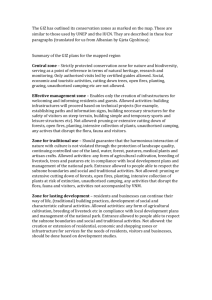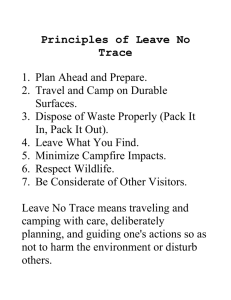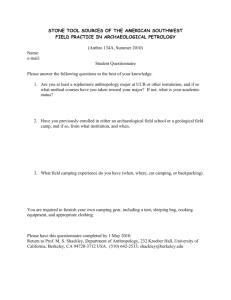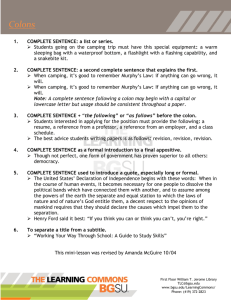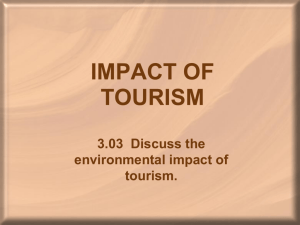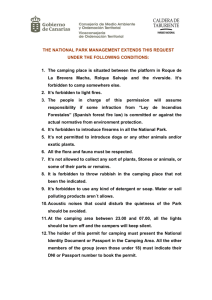Research Journal of Mathematics and Statistics 4(3): 76-83, 2012 ISSN: 2040-7505
advertisement
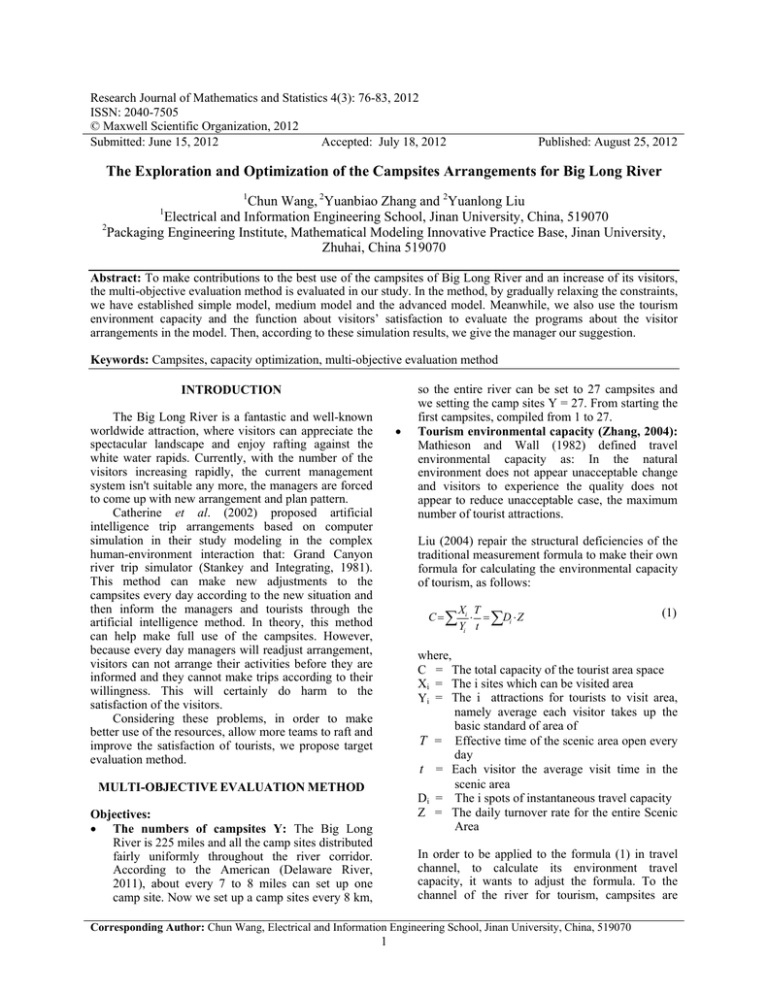
Research Journal of Mathematics and Statistics 4(3): 76-83, 2012 ISSN: 2040-7505 © Maxwell Scientific Organization, 2012 Submitted: June 15, 2012 Accepted: July 18, 2012 Published: August 25, 2012 The Exploration and Optimization of the Campsites Arrangements for Big Long River 1 Chun Wang, 2Yuanbiao Zhang and 2Yuanlong Liu Electrical and Information Engineering School, Jinan University, China, 519070 2 Packaging Engineering Institute, Mathematical Modeling Innovative Practice Base, Jinan University, Zhuhai, China 519070 1 Abstract: To make contributions to the best use of the campsites of Big Long River and an increase of its visitors, the multi-objective evaluation method is evaluated in our study. In the method, by gradually relaxing the constraints, we have established simple model, medium model and the advanced model. Meanwhile, we also use the tourism environment capacity and the function about visitors’ satisfaction to evaluate the programs about the visitor arrangements in the model. Then, according to these simulation results, we give the manager our suggestion. Keywords: Campsites, capacity optimization, multi-objective evaluation method INTRODUCTION The Big Long River is a fantastic and well-known worldwide attraction, where visitors can appreciate the spectacular landscape and enjoy rafting against the white water rapids. Currently, with the number of the visitors increasing rapidly, the current management system isn't suitable any more, the managers are forced to come up with new arrangement and plan pattern. Catherine et al. (2002) proposed artificial intelligence trip arrangements based on computer simulation in their study modeling in the complex human-environment interaction that: Grand Canyon river trip simulator (Stankey and Integrating, 1981). This method can make new adjustments to the campsites every day according to the new situation and then inform the managers and tourists through the artificial intelligence method. In theory, this method can help make full use of the campsites. However, because every day managers will readjust arrangement, visitors can not arrange their activities before they are informed and they cannot make trips according to their willingness. This will certainly do harm to the satisfaction of the visitors. Considering these problems, in order to make better use of the resources, allow more teams to raft and improve the satisfaction of tourists, we propose target evaluation method. so the entire river can be set to 27 campsites and we setting the camp sites Y = 27. From starting the first campsites, compiled from 1 to 27. Tourism environmental capacity (Zhang, 2004): Mathieson and Wall (1982) defined travel environmental capacity as: In the natural environment does not appear unacceptable change and visitors to experience the quality does not appear to reduce unacceptable case, the maximum number of tourist attractions. Liu (2004) repair the structural deficiencies of the traditional measurement formula to make their own formula for calculating the environmental capacity of tourism, as follows: C Xi T Di Z Yi t (1) where, C = The total capacity of the tourist area space Xi = The i sites which can be visited area Yi = The i attractions for tourists to visit area, namely average each visitor takes up the basic standard of area of T = Effective time of the scenic area open every day t = Each visitor the average visit time in the scenic area Di = The i spots of instantaneous travel capacity Z = The daily turnover rate for the entire Scenic Area MULTI-OBJECTIVE EVALUATION METHOD Objectives: The numbers of campsites Y: The Big Long River is 225 miles and all the camp sites distributed fairly uniformly throughout the river corridor. According to the American (Delaware River, 2011), about every 7 to 8 miles can set up one camp site. Now we set up a camp sites every 8 km, In order to be applied to the formula (1) in travel channel, to calculate its environment travel capacity, it wants to adjust the formula. To the channel of the river for tourism, campsites are Corresponding Author: Chun Wang, Electrical and Information Engineering School, Jinan University, China, 519070 1 Res. J. Math. Stat., 4(3): 76-83, 2012 2 = U3 = equivalent to traveling scenic area and each scenic spot can accommodate a group of tourists. In addition, the time to travel from 6 to 18 nights, so here can't press day calculation, but according to the years calculation. Now we will adjust formula is as follows: C' si T ' Y Z' si t ' 3 = (2) where, C ' = The channel of the river tourist area’s total capacity in six months Si = The area of the i camping point, is also the tourists visit area T ' = The channel of the river scenic spots (where visitors play) a year of effective opening time t ' = Each visitor in the scenic area average visit time Y = The numbers of the camp sites Z ' = The whole river the annual turnover of tourist scenic spot The choice of travel time U1: When managers give more types of travel time, visitors will be more satisfied. Because visitors can choose according to oneself, choosing the most appropriate own travel time. So, there are: U1 x (4) xmax where, = Scores of travel time U1 x = The types of travel time x max = Most types of travel time Because the passenger cost about 6 to 18 nights go all the way, namely the tourists had 13 kinds of choice: xmax 13 . Every day the tourists driving time: Subject mentioned that travel from beginning to end need 6 to 18 nights and the ship's speed is fixed. If visitors choose the oar-powered rubber rafts, which travel on average 4 mph, driving time every day is 3.1259.375 h; and if choose the motorized boats, which travel on average 8 mph, it need 1.76-4.6875 h every day driving The numbers of the campsites tourists pass every day: In the information, the fastest visitors arrive at the destination only six nights, which is average 4.5(4.5 = 27÷6) campsites every day. The slowest visitors only need 18 nights, which is average 1.5(1.5 = 27÷18)campsites every day Tourists satisfaction functions: The satisfaction of tourists will decide whether tourists travel many times. In the river tourism, the influence of the satisfaction degree of the tourists are the major factors to the choice of the travel time, take the ship's type and the number of visitors and other meet. In practice, there are more, such as ticket price and service quality, but here we don't consider. So, we define the satisfaction degree of the function is as follows: P 1U 1 2U 2 3U The type of ship accounted for by weight Meet with other visitors the number of points Meet with other visitors times the weight of occupied The kinds of ships U2: Here are 2 types of ship, one is oar-powered rubber rafts, which travel on average 4 mph, the other is motorized boats, which travel on average 8 mph. 0 .5 U2 1 Only a ship choice (5) Two kinds of ship choice where, U2 is ship type of score. The number of the boat contact with other groups U3: The number that one boat meets with other boat is large, the few the tourists can enjoy field experience and satisfaction will fall. So the number of meet score defined as follows: U3 1 x' x'max (6) where, U3 = The number of points meet with other visitors x' = The number of other tourists meet x' max = The maximum number that meet with other visitors (3) where, P = The satisfaction of tourists U1 = Time to choose a score with tourism 1 = The choice of time Europe accounted for by weight U2 = The type of score points In multi-objective evaluation methods, it can be seen that the biggest number of one boat contact with the other boats are 15 times. In practice, the number may be much more, but for evaluation model of the scheme, meet the highest number of for 10 times is reasonable, so we take x'max 15 . 77 Res. J. Math. Stat., 4(3): 76-83, 2012 The weight of 3 factors : The proportion of all Table 1:Numbers of the camping point for campers who take oarpowered rubber rafts Types Numbers of the camping point A 3, 6, 9, ……, 27 B 2, 5, 8, ……, 26 C 1, 4, 7, ……, 25 n factors together, to get the weight for: i 1 . i1 For the lack of information and data, we use the relative comparison method [10] to determine the subjective right to weigh. Three ratio of the scale q ij in the method is: 1 qij 0.5 0 When X i more important than X j ; When X i and X j have the same important ; Table 2:Numbers of the camping point for campers who take motorized boats Types Numbers of the camping point a 6, 12, 18, 24 b 5, 11, 17, 23 c 4, 10, 16, 22 d 3, 9, 15, 21, 27 e 2, 8, 14, 20, 26 f 1, 7, 13, 19, 25 (7) When X i less important than X j According to actual condition, comprehensive consideration of the tourists, get score matrix: 1 0.5 1 Q 0 0.5 0 0 1 0.5 Tourism Environmental Capacity: C' (8) Satisfaction function: So i (0.56,0.11,0.33) ,generation into the satisfaction of tourists function formula (3): P 0.56U 1 0.11U 2 0.33U 3 P 0 .56U 1 0 .11U 2 0 .33U 3 0 .56 (9) A simplified model: Simple model is to simplify complex situations, some unstable factors stabilizing treatment. The following assumptions: Assume that each group of tourists follows the managers of the arrangements required by the managers to do Suppose each group of visitors in addition to time drifting in the river, other times are spent in the camping point 1 0 .11 0 .5 0 .33 1 0 .43 13 The distance interval between each group of visitors: 8 miles. The time interval between each group of visitors: 8 miles ÷ 4 miles /h = 2 h. Day can be arranged groups: 3 groups. A group of tourists to meet with other groups of tourists: 0 times. The managers of the arrangements are as follows: Arrangements for the three groups of tourists every day for river travel, ride 4 miles h of the rubber raft. In one day, when arrangements for the next group of visitors for tourism, the time interval of at least 2 h. There rules for rafting: si T ' 6 30 Y Z ' 27 540 si t ' 9 Managers arrange tourist campsites every day. Visitors daily driving time is fixed, the driving speed is fixed, that is, the travel time is fixed. To oar-powered rubber rafts, Daily driving time is 6 h (6 h ≈ (3.125 h+9.375 h)/2);To motorized boats, it is also the time as oar-powered rubber rafts Daily driving. The tourists can not choose to take the ship, only to take the ship that the river managers Provide. There are 2 types of vessel, rubber rafts is 4 mph and the other is 8 miles/h of motorized boats. 8 mph motorboat: The average daily driving distance number: 8 miles/h*6h = 48 miles The camping number that visitors will be can be seen in Table 2 and Fig. 2: Tourism Environmental Capacity: C' si T ' 6 30 Y Z ' 27 972 si t ' 5 Satisfaction function: Camping point number has set to 27, now point 2 types of ships discussion: 4 mph of oar-powered rubber rafts: o The average daily driving distance number: 4 mph*6 h = 24 miles o Numbers of the camping point for campers who take oar- powered rubber rafts (Table 1 and Fig. 1): P 0.56U 1 0.11U 2 0.33U 3 0.56 78 1 0.11 0.5 0.33 1 0.43 13 The distance interval between each group of visitors: 8 miles Res. J. Math. Stat., 4(3): 76-83, 2012 Fig. 1: The camping route for campers who take oar-powered rubber rafts. “ 、 、 ” shows different camping points for campers, while different shapes of graphics connected to a set of campers' camping route. Capital letters show the campers who take oar-powered rubber rafts Fig. 2: The camping route for campers who take motorized boats. “ 、 、 、 、 、 ” shows different camping points for campers, while different shapes of graphics connected to a set of campers’ camping route. Small letters show the campers take motorized boats Table 3: Serial number of campsites of combination of the motorized boats and the r rubber rafts Numbers of the camping point ----------------------------------------------------------------Types Oar-powered rubber rafts Motorized boats b 5, 11, 17, 23 c 4, 10, 16, 22 I A 3, 6, 9, ……, 27 e 2, 8, 14, 20, 26 f 1, 7, 13, 19, 25 a 6, 12, 18, 24 c 4, 10, 16, 22 II B 2, 5, 8, ……, 26 d 3, 9, 15, 21, 27 f 1, 7, 13, 19, 25 a 6, 12, 18, 24 b 5, 11, 17, 23 III C 1, 4, 7, ……, 25 d 3, 9, 15, 21, 27 e 2, 8, 14, 20, 26 A 3, 6, 9, ……, 27 c 4, 10, 16, 22 IV B 2, 5, 8, ……, 26 f 1, 7, 13, 19, 25 A 3, 6, 9, ……, 27 b 5, 11, 17, 23 V C 1, 4, 7, ……, 25 e 2, 8, 14, 20, 26 B 2, 5, 8, ……, 26 a 6, 12, 18, 24 VI C 1, 4, 7, ……, 25 d 3, 9, 15, 21, 27 An intermediate model: The intermediate model is based on the simple model. It relaxes the restrictions of the simple model. In the model, visitors can use 2 kinds of the ships. The installation of the campsites and the installation of the travel time are the same with the simple model which has 27 campsites. The driving time is 6 h every day and visitors can do according to the requirements of managers. Now, there are two kinds of available ship. In order to making full use of the campsites and let many groups of tourists not live in the same campsites, the new combination is shown in Table 3 and Fig. 3. In Table 3, we can see visually that the essences of I, II and III combination type are the same. The essences of IV, V and VI combination type are the same. The difference is that the departure time for different kinds of ship's is different. For I, II and III combination type: The time interval between each group of visitors: 8 miles÷8 miles/h = 1 h One day can be arranged groups: 6 groups The number of one group of tourists contact with others groups of visitors: 0 time The number of encounters: The formula of the number of meeting of a group of tourists with other groups of visitors is as follows: N N1 N 2 The managers of the arrangements are as follows: Every day, arrange six groups of tourists by motor boat for river travel, whenever arrangements for the next group of visitors for tourism interval of at least 1 h. (10) where, N = The number of meeting of a group of tourists with other groups of visitors 79 Res. J. Math. Stat., 4(3): 76-83, 2012 Fig. 3: The camping route for campers who choose combination type of I、II、III “ 、 、 、 、 ” shows different camping points for campers, while different shapes of graphics connected to a set of campers’ camping route. Capital letters show the campers who take oar-powered rubber rafts. Small letters show the campers take motorized boats Fig. 4: The camping route for campers who choose combination type of IV、V、VI. “ 、 、 、 ” shows different camping points for campers, while different shapes of graphics connected to a set of campers' camping route. Capital letters show the campers who take oar-powered rubber rafts. Small letters show the campers take motorized boats N1 = The number of meeting of a group of tourists with other groups of visitors on the motorized boats N2 = The number of meeting of a group of tourists with other groups of visitors on the rubber rafts in the simple model. The intermediate model involves two travel times, so we have to calculate the average of them. We can find that visitors on the motorized boats occupy two successive campsites of every 3 campsites if we observe the situation of I, II and III combination type campsites carefully. Visitors on the rubber rafts occupy the third campsite. The 3 successive campsites form a cycle. So the average visiting time of the tourists is: We assume that visitors observe the management requirements strictly as long as the difference of the time of departure or arrival time is less than one hour, the same kind of ship will not meet. The reason is that it takes the motorized boats an hour from a campsite to another adjacent campsite; for the rubber rafts, it takes 2 h. So, the number of meeting of a group of tourists on the motorized boats with other groups of visitor: N N1 N 2 0 1 t' So, we know: 45 4 .5 2 C' It takes only 4 or 5 days for visitors on the motorized boats to arrive at the destination, so they only meet 1 time with the groups of visitors on the rubber rafts and will not meet with the groups of visitors on the motorized boats in a day. They will meet four times in four days. They will also meet four times in four days, so we take the average. The number of meeting of a group of tourists on the rubber rafts with other groups of visitor: N N1 N 2 2 449 5.67d 3 si T ' 6 30 Y Z ' 27 857.14 si t ' 5.67 Therefore, the tourism environment capacity of I, II and III combination types is 857.14. Satisfaction function: Due to the times of meeting the tourists on the motorized boats and the tourists on the rubber rafts is not the same so that we take an average. As a result, the average number of meeting with other visitors is: (9 + 4.5) ÷ 2 = 6.75 (Fig. 4). So satisfaction function of visitors is: 45 09 2 P 0.56U 1 0.11U 2 0.33U 3 The tourism environmental capacity: The tourism environment capacity in the Intermediate model is a little different with the tourism environmental capacity 0.56 80 4 6.75 0.11 1 0.33 (1 ) 0.46 13 15 Res. J. Math. Stat., 4(3): 76-83, 2012 For IV and V and VI combination type: Satisfaction function: P 0 .56U 1 0.11U 2 0.33U 3 The number of encounters: The number of the motorized boats meets with other visitors: N N1 N 2 0 2 0.56 45 9 2 Manager’s arrangement: In order to reduce the numbers to meet other passengers, for I, II and III combination type, every day will be arranged by the motor boats 4 sets of campers who taking motorized boats and 1 set of campers who taking oar-powered rubber rafts to set off. So, in a row of camping sites, after each successive 2 camping point lived the campers who taking motorized boats, there will be a camping point lived the campers who taking oar-powered rubber rafts and constantly cycle Also, managers can choose one in the I, II and III combination type. For IV and V and VI combination type, every day will arrange two sets of campers who taking motorized After analysis, we can see the motorboat visitors will meet with the rubber raft tourists two times. The numbers of the oar-powered rubber rafts meet with other visitors: N N1 N 2 1 45 0 4.5 2 We can see the oar- powered rubber rafts only meet with the motorboat visitors one times. Tourism environmental capacity: Combination of Type IV, V, VI, We can see that every three camp sites for two camp sites are oar- powered rubber rafts tourists to live, a camp sites is motorboat visitors live and loop for a period of 3 campsites. Therefore, visitors' average time to visit is: t' Table 4: Numbers of the "new camping point" for campers Numbers of the "new camping point" ----------------------------------------------------------------Types Oar-powered rafts Motorized boats I A 1, 2, ……, 13; a 3, 6, 9, 12; II b 2, 5, 8, 11; c 1, 4, 7, 10 a 2, 4, 6, 8, 10, 12; III b 1, 3, 5, 7, 9, 11, 13 IV a 1, 2, 3, ……, 13 a 3, 6, 9, 12; V A 1, 2, 3, ……, 13 b 2, 5, 8, 11; c 1, 4, 7, 10 a 2, 4, 6, 8, 10, 12; VI A 1, 2, 3, ……, 13 b 1, 3, 5, 7, 9, 11, 13 VII A 1, 2 , 3, ……, 13 a 1, 2, 3, ……, 13 499 7.33d 3 C' 1 6.75 0.11 0.33 (1 ) 0.46 13 15 si T ' 6 30 Y Z ' 27 663.03 si t ' 7.33 Therefore, IV, V, VI combination of types of tourism environmental capacity is 663.03. Fig. 5: "new camping point" distribution. “ ” Shows "original camping point". “ Fig. 6: "new camping point" distribution。“ ” Shows the original camping point,“ 81 ” shows "new camping point" ” shows "new camping point" Res. J. Math. Stat., 4(3): 76-83, 2012 Table 5: Seven types are compared Types ------------------------------------------------------------------------------------------------------------------------------Project i ii iii iv v vi vii The number of meeting 0 0 0 0 15 14 0 Tourism environmental capacity 180 585 360 180 275.29 240 360 Satisfaction 0.43 0.43 0.47 0.43 0.20 0.22 0.43 Do not calculate the number of meeting when a different sets of campers and living in the same "new camping point" Table 6: Numbers of the "new camping point" for campers Numbers of the "new camping point" --------------------------------------------------------------Oar-powered rubber rafts Motorized boats Types (i) A 1, 2, 3, ……., 9 a 2, 4, 6, 8; (ii) b 1, 3, 5, 7, 9 (iii) a 1, 2, 3, ……, 9 a 2, 4, 6, 8; (iv) A 1, 2, 3, ……, 9 b 1, 3, 5, 7, 9; (v) A 1, 2, 3, ……, 9 a 1, 2, 3, ……, 9 boats and 2 sets of campers who taking oar-powered rubber rafts to set off. Similarly, in a row of camping sites, after each successive two camping point lived the campers who taking oar-powered rubber rafts, there will be a camping point lived the campers who taking motorized boats and constantly cycle. Also, managers can choose one in the IV and V and VI combination type. Combination of the 2 types of analysis: Due to offer two kinds of ship, the satisfaction of the campers higher than the simple model, but tourism environmental capacity is not more than a simple model. For managers, there are two kinds of combination type scheme can be implemented and satisfaction of the campers in two kinds of combination type is the same, but I, II and III combination type of tourism environment capacity slightly higher than IV, V, VI combination type. Managers should give priority to I, II and III combination type of plan. point" can be 1, 2, 3, or 4 original camping points into 1 a "new camping point". But, a former camping point will not have to reset. In addition, for the campers taking the oar-powered rubber rafts, even daily driving 6 h and most can only pass 3, so unnecessary to consider four original camping points into 1 "new camping point". Every 2 camping point as 1 "new camping point" and to Numbers (Numbers from 1 to 13) (Fig. 5). The campers who take oar-powered rubber rafts most can only pass 3 original camping sites, converting 1.5 "new camping point". If one day according to 2 new camping point calculation, the type will be repeat to the intermediate model. Visitors can't choose oneself live camping point, so the campers who taking oar-powered rubber rafts can only tour pass 1 "new camping point". The campers who taking the motorized boats can only pass 3 "new camping point" per day. The campers will camping the Numbers of "new camping point" (Table 4), more situation Table 5. Every 3 camping point as a "new camping point" and to Numbers (Numbers from 1 to 9) (Fig. 6). Also, the campers who taking oar-powered rubber rafts can pass 1"new camping point" everyday; And the campers who taking motorized boats most can only pass 2 "new camping point". The campers will camping the Numbers of "new camping point" (Table 6), more situation Table 7. Contrast Table 5 and 7, easy to find tourist environmental capacity was slightly higher when 2 original camping point into 1 "new camping point", but satisfaction slightly lower. Because for the 2 camping points into 1 "new camping point", the tourists range of activities in 3 original than camping point into 1 a "new camping point" small range of activities, the satisfaction of the campers have declined, but also because the original camping the utilization rate of some high points, can increase more visitors to river trips. An advanced model: The advanced model is based on the intermediate model and then relaxed the travel time limit, campers can decide today how long to flow and the time to rest. For setting 27 camping points, the figure is correct or not, we shall not care. The key is based on the 27 camping points, reasonable arrangement of tourists, in order to achieve the maximum capacity of the tourism environment. And then, how much the number of camping points Y to set, which will carry on the relevant discussion. For travel time, the speed of the ship is fixed, but every time by tourists is drifting their decision. Managers also is very difficult to determine where visitors will camp, how many days to camp in the same camping points. In addition, visitors’ strength and the trip will also affect the scenery tourists traveling speed. Generally speaking, the manager does not know the campers will live the next day. He only know the scope of the roughly, so according to the thought of adjacent camping percentage points, defined as a new "camping point". Although he utilization rate of the original camping t points is lower, but still acceptable. In addition, visitors have a right to choose their camp to locations and control of the time every day drifting power. So, the satisfaction degree of the tourists would be high. Because campers every day can pass an average number of camping points is 1.5-4.5, so "new camping 82 Res. J. Math. Stat., 4(3): 76-83, 2012 Table 7: Five types are compared Types -----------------------------------------------------------------------------------------------------------------------------Project I II III IV V The number of meeting 0 0 0 10 0 Tourism environmental capacity 180 360 180 240 360 Satisfaction 0.43 0.47 0.43 0.35 0.48 Do not calculate the number of meeting when a different sets of campers and living in the same "new camping point" capacity and the corresponding satisfaction analysis, we can conclude that senior model enjoys the best total benefit. In advanced model, there is the highest satisfaction in the scheme (v). Based on the point of view of the managers, should make full use of camping point, improve tourism environmental capacity, so led to consider the satisfaction are not high, which influence of tourists travel quality. Based on this, we think scheme (v) is the best in the advanced model REFERENCES Catherine, A.R., S. Doug and A.B. Joanna, 2002. Modeling complex human-environment interaction: The Grand Canyon river trip simulator. Ecol. Mod., 153(1-2): 181-196. Delaware River, 2011. Up the River with a Paddle Paddling Trips. Retrieved from: http:// www. dingmanscampground.com / RiverTrips.aspx. Liu, Y., 2004. Large scenic tourist environmental capacity of measuring method and explore. Travel J., pp: 210-240. Mathieson, A. and G. Wall. 1982. Tourism: Economic, Physical and Social Impacts. 2nd Edn., Longman, London, pp: 208, ISBN: 0582300614. Stankey, G.H., 1981. Integrating wildland recreation research into decision making: Pitfalls and promises. Recret. Res. Rev., 9(1): 31-37. Zhang, X., 2004. Tourism environment capacity research: from the theory framework to management tools. Res. Sci., pp: 35-56. CONCLUSION AND DISCUSSION As for the first method, the simple model assumes that a visitor can only choose one kind of trip, so that motor boats can maximize the efficiency of the use of the campsites and win the most profit for the managers. Besides, the river capacity can be increased by setting the locations of the campsites. However, this method suffer the least satisfaction from the visitors, in the medium model, visitors can choose rubber boats or motor boats. Then, the managers have a choice of two models, but yield lower profit than the simple model would bring to them. However, the visitors' satisfaction can be improved. In senior model, managers have less limitation on the travel time, which is more practical. At this time, managers have very few restrictions on to visitors. Visitors can choose the pattern of trips according to their own will therefore, the visitors’ satisfaction is higher, but will make the river capacity decline. All models, combining tourism environment 83
